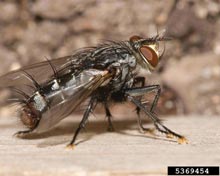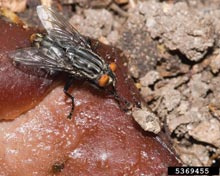
Susan Ellis

Susan Ellis
Flesh Flies
General Descriptions
Appropriately named, flesh flies usually seek carrion or scraps of meat on which to lay their eggs. Like house
flies, adult flesh flies are dark-colored (gray or black). Common species have three dark stripes on the thorax.
They are slightly more than one-fourth of an inch long and have a checkerboard pattern on the abdomen.
General Control
Eliminate fly breeding sites by locating the attracting material. Proper sanitation at dumpster and trash
receptacles can help reduce the number of flies that are attracted to the site. Barriers such as screening not less
than 16-mesh, and tight-fitting, self-closing doors that are kept closed when not in use will reduce the number of
flies that enter structures.
In addition to fly swatting, mechanical fly control includes trapping with the use of sticky fly paper and ultraviolet light traps. To be effective, light traps must be properly placed. They should be placed where they cannot be seen from outside the building, no more than 5 feet above the floor and away from competing light sources and food preparation areas.
While the use of pesticides is usually not the best means of managing filth fly problems, sometimes chemical control can be a valuable component of an integrated fly management program. Often this type of control provides only temporary relief and cannot be relied upon to eliminate the problem.









